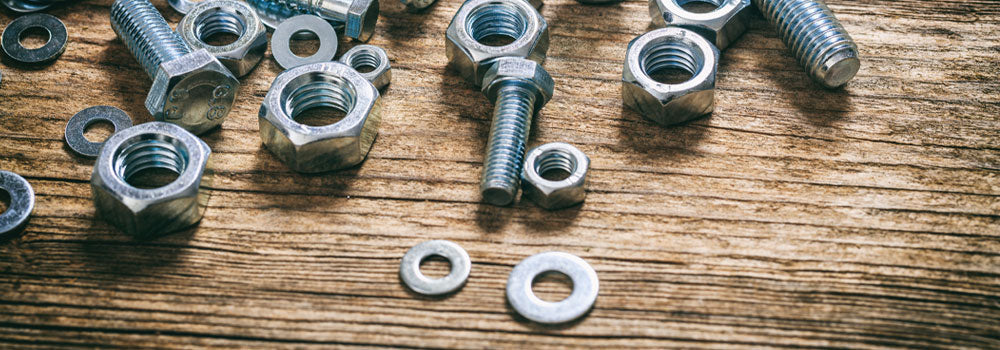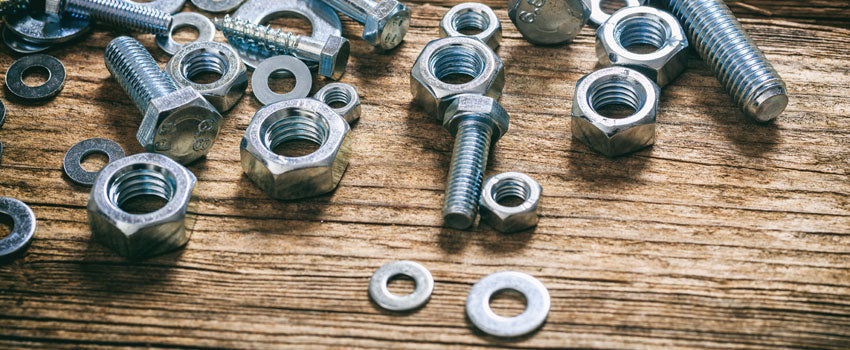
Understanding Markings and Grades on Nuts and Bolts
Why do Nuts and Bolts have Markings?
When shopping for nuts and bolts, you may have noticed the fastener's head has markings engraved. These markings have a specific purpose that will help you understand the fastener more in-depth. The markings are an indication of the fastener's make, material, and dimension.
The tool manufacturer engraves these markers as a helpful way for customers to be aware of what they are purchasing and using. Each manufacturer is required to engrave a unique marker that is specific to their brand. The brand marker is especially helpful as it allows you to trace the fastener back to the manufacturer if there is a defect. Watch the video below to learn more!
Common Markings on Nuts and Bolts
When it comes to nuts and bolts, there are many markings that you may come across. Common markers include letters, numbers, dashes, slashes, dots, and many more. Many nuts and bolts follow SAE or Metric standards ensuring strength and reliability.
SAE vs. Metric Markings
SAE Bolt Head Markings
The Society of Automotive Engineers created a system of grades to identify valuable information about the fastener. The grades of a fastener can represent what material it is made out of, its hardness range, and its strength characteristics. SAE grades use the imperial measurement system. The imperial measurement system uses inches.
The SAE J429 standard has specific requirements for bolts, screws, studs, sems, and U-bolts up to 1-1/2" in diameter. Bolts meeting SAE J429 standards have radial lines engraved on the bolt head.
Grade 2, 5, and 8 are the most common grades of fasteners according to the Society of Automotive Engineers standard. The higher the grade is, the stronger the material that makes up the fastener. The grade also represents the tensile strength, yield strength, and proof load of a fastener.
SAE Grade 2
-
Does not have any radial line markings
-
Lowest SAE grade with the least strength
-
Comprised of low or medium carbon steel
SAE Grade 5
-
Have three radial lines engraved
-
Medium level strength
-
Comprised of medium quenched and tempered carbon steel
SAE Grade 8
-
Have six radial lines engraved
-
Highest SAE grade with the most strength
-
Comprised of medium quenched and tempered carbon alloy steel
Metric Bolt Head Markings
Metric classes are set by the ISO (International Standards Organization). Metric markings combine two numbers separated by a dot. The number markings are engraved on the top or side of the bolt head. Common metric classes are 5.8, 8.8, 10.9, and 12.9. The higher the numbers are, the stronger the material of the fastener is.
The number that appears before the decimal, when multiplied by 100, will provide the approximate minimum tensile strength of the bolt. The number after the decimal, when multiplied by 10, will provide the approximate yield strength percentage in relation to the minimum tensile strength.
304 Stainless Steel Bolt Head Markings
Metric bolts made of 304 stainless steel are marked on the bolt head with A2-70. The A2 represents 304 stainless steel and 70 represents the tensile strength. The tensile strength equals 700 MPA general-purpose stainless steel. The number after the A2 will vary depending on the tensile strength of the bolt. 304 stainless steel has decent corrosion resistance.
316 Stainless Steel Bolt Head Markings
Metric bolts made of 316 stainless steel are marked on the head of the bolt with A4-70. The A4 represents 316 stainless steel and the 70 represents the tensile strength. The tensile strength equals 700 MPA marine grade stainless steel. The number after the A4 will vary depending on the tensile strength of the bolt.
The 316 stainless steel grade has high resistance to corrosion. The 316 stainless steel bolt is commonly used near salt water and a variety of other exterior applications.
Tensile Strength
Before using any fastener, being aware of its tensile strength, proof load, and yield strength is crucial so the fastener doesn't break or lose its elasticity during use.
Tensile strength is the amount of stress or load that the fastener can withstand by a material before it stretches and breaks. The tensile strength is tested by applying mechanical loads to the fastener. This amount of pressure determines its resilience. Understanding tensile strength is incredibly important when choosing hardware so it is clear if it is strong enough for the application.
Proof Load
Proof load is the limit of the elastic range of a bolt. If a bolt is tensioned beyond its specified proof load, it can't be used as it experiences plastic deformation. If it is tensioned within its specified proof load and has kept its original size and shape, it can be reused. Once the proof load is exceeded, it starts to yield and lose ductility.
Yield Strength
Lastly, yield strength is the maximum amount of stress a fastener can withstand before its shape is sufficiently deformed. Any deformation caused by stress greater than the yield strength results in the hardware being nonrecoverable for use.
Bolt Head Markings Chart
US Bolts |
|||||
| Head Marking | Grade and Material |
Nominal Size Range (inches) |
Mechanical Properties | ||
|---|---|---|---|---|---|
| Proof Load (psi) |
Min. Yield Strength (psi) |
Min. Tensile Strength (psi) |
|||
 |
307ALow carbon steel |
1/4" thru 4" | N/A | N/A | 60,000 |
|
No Markings |
Grade 2Low or medium carbon steel |
1/4" thru 3/4" | 55,000 | 57,000 | 74,000 |
| Over 3/4" thru 1-1/2" | 33,000 | 36,000 | 60,000 | ||
 3 Radial Lines |
Grade 5Medium carbon steel, quenched and tempered |
1/4" thru 1" | 85,000 | 92,000 | 120,000 |
| Over 1" thru 1-1/2" | 74,000 | 81,000 | 105,000 | ||
 6 Radial Lines |
Grade 8Medium carbon alloy steel, quenched and tempered |
1/4" thru 1-1/2" | 120,000 | 130,000 | 150,000 |
 |
Grade A325Carbon or alloy steel with or without boron |
1/2" thru 1-1/2" | 85,000 | 92,000 | 120,000 |
| Stainless Markings Vary |
18-8 & 316 StainlessSteel alloy with chromium and nickel |
All sizes thru 1" | N/A | 20,000 Min. 65,000 Typical | 65,000 Min. 100,000 – 150,000 Typical |
 |
651 Silicon bronzeAn alloy of mostly copper and tin with a small amount of silicon |
1/4" thru 3/4" | N/A | 55,000 | 70,000 |
| 7/8" thru 1-1/2" | N/A | 40,000 | 55,000 | ||
 |
Aluminum 2024Aluminum alloy with copper, magnesium and manganese; solution heat treated and age hardened |
All sizes | N/A | 36,000 | 55,000 |
Metric Bolts |
|||||
| Head Marking | Class and Material |
Nominal Size Range (mm) |
Mechanical Properties | ||
| Proof Load (MPa) |
Min. Yield Strength (MPa) |
Min. Tensile Strength (MPa) |
|||
 |
Class 8.8Medium carbon steel, quenched and tempered |
All sizes below 16mm | 580 |
640 |
800 |
| 16mm - 72mm | 600 | 660 | 830 | ||
 |
Class 10.9Alloy steel, quenched and tempered |
5mm - 100mm | 830 |
940 |
1040 |
 |
Class 12.9Alloy steel, quenched and tempered |
1.6mm - 100mm | 970 |
1100 |
1220 |
| Usually Stamped A-2 or A-4 |
A-2 & A-4 StainlessSteel alloy with chromium and nickel |
All sizes thru 20mm | N/A |
210 Min. |
500 Min. |
|
Tensile Strength: The maximum load in tension (pulling apart) which a material can withstand before breaking or fracturing. Yield Strength: The maximum load at which a material exhibits a specific permanent deformation. Proof Load: An axial tensile load which the product must withstand without evidence of any permanent set. 1MPa = 1N/mm2 = 145 pounds/inch2 |
|||||
Screw Markings
Many screws have consistent markings that make it easy to distinguish the size of the screw. Conquest screws, for example, have the length in the decimal form for inches stamped on the head of the screw. Additionally, the Conquest concrete screws include a shield symbol stamped on the head of the screw that represents the Conquest brand.

Wedge Anchor Markings
The markings for concrete wedge anchors differ from screws. Conquest wedge anchors, for example, have a letter marked on the head of the anchor. The letter signifies the length of the fastener. Check out the spec sheet for the Conquest wedge anchors to see what the letters equate to in length sizes. Conquest wedge anchors also have a Conquest shield stamped on the clip at the bottom of the fastener.






